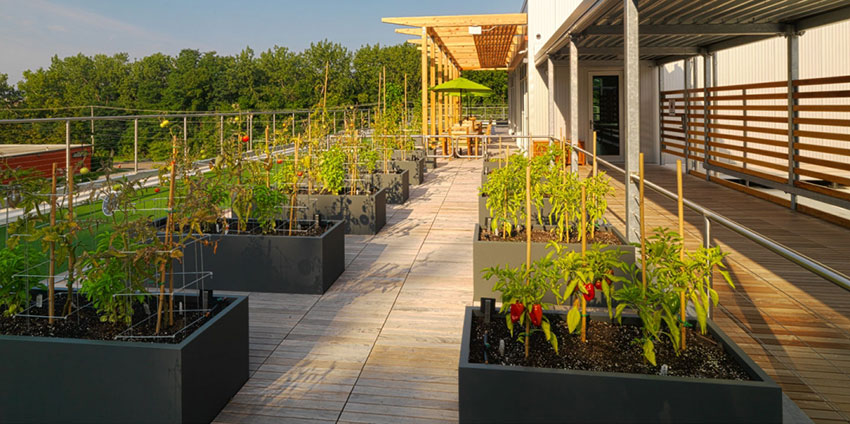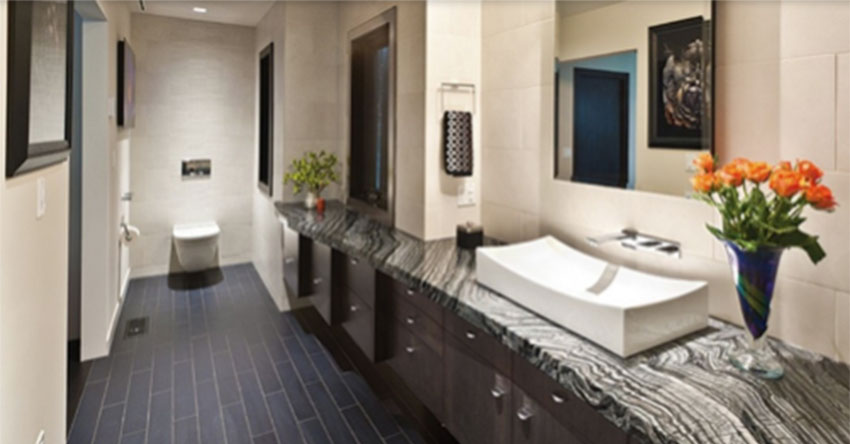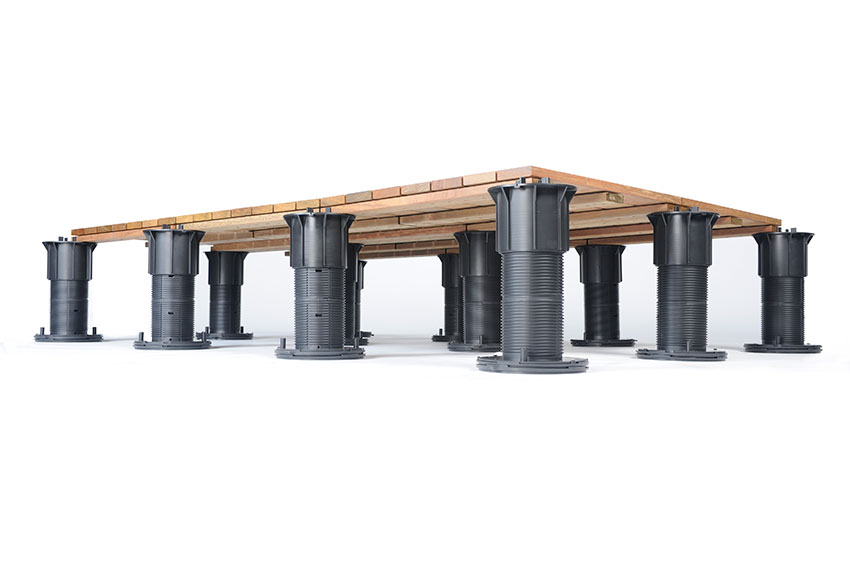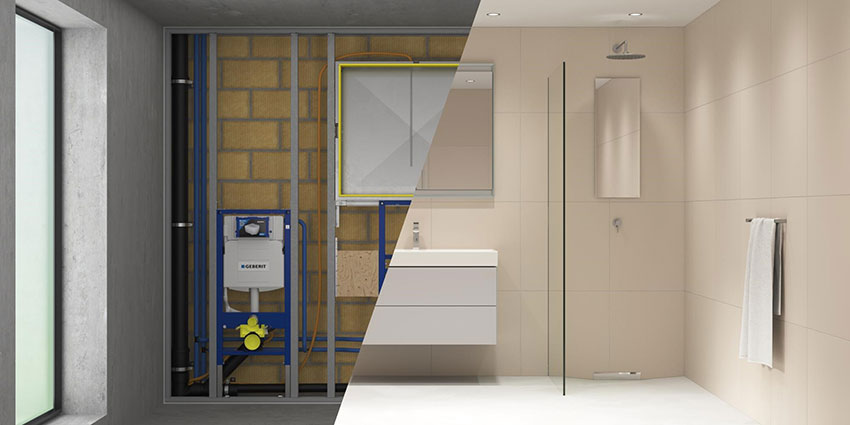Old Buildings – New Life
- Nourishment: N12: Food Production
- Movement: V04: Facilities for Active Occupants; V05: Site Planning and Selection; V06: Physical Activity Opportunities; V08: Physical Activity Spaces and Equipment
- Materials: X07: Materials Transparency; X08: Materials Optimization.
- Mind: M02: Nature and Place; M07: Restorative Spaces.
Incorporating outdoor raised deck areas, whether on patios, rooftops, balconies, or pop-up parks, clearly provides multiple opportunities to create more sustainable and healthier environments in renovated and adaptive re-use projects.

Photo courtesy of Bison Innovative Products
Sustainability and wellness goals can be met using standard outdoor deck components including modular planters that are used in this application for growing vegetables for a restaurant.
IMPROVED TOILET INSTALLATIONS
It is clear that sanitation, safety, and sustainability have been and will remain important considerations for all users of renovated buildings. These are regulated by well-known standards and codes that in-wall toilet systems are proven to meet or exceed. These include the International Building Code (IBC), International Plumbing Code (IPC), the Universal Plumbing Code, and the National Plumbing Code of Canada (NPCC) as well as standards of the American Society of Plumbing Engineers (ASPE), the American Society of Mechanical Engineers (ASME). They also can achieve EPA WaterSense certification for Tank Type Toilets for reduced water use. Based on these codes and standards, one common design goal in restrooms is to control the amount of water used. This is particularly true for flushable toilets where the design of the flow mechanism and the controls that actuate it are critical. Wall-hung toilets and touchless flush pates are becoming the new standards in many cases since they offer superior features in performance as well as design. In particular, those that use in-wall tanks concealed from view and user access provide improved water flow control with cleaner looks, quieter operation, and the potential for cleaner restrooms in general. While some may think that a high-performance toilet solution needs to look clinical or austere, the reality is that there are contemporary design alternatives. That means architects do not have to lose their design concepts to achieve critical performance features. Rather, there are innovative product solutions that meet the demand for sanitation, safety, and sustainability while also providing a high level of design. In order to accommodate a range of different project types, particularly for renovation, retrofit, or adaptive re-use, there are multiple options available. Beyond the aesthetic benefits, there are also clear space savings achieved by recessing the toilet tank system into the wall, allowing for more usable space in restrooms in many cases. In addition to better water control that is available from dual flush actuators, in-wall systems are a reliable and high-quality solution for designing contemporary bathrooms that meet the demands of all involved. Overall sanitation and safety are improved by having less of the toilet system exposed and the bowl raised up from the floor. This adds to the comfort and convenience for users as well as ease of cleaning for janitorial crews. In terms of maintenance, all working parts remain easily accessible, although the high reliability of this type of unit reduces the need for maintenance crews to access it in the first place. Commonly, the support frame is based on solid steel construction with a seamless, one-piece tank made of durable, leak-free, high-density polyethylene. Units are commonly tested and proven to support up to 880 lbs. (400 kg) without deforming the frame or the wall.
Photo courtesy of Geberit
The use of in-wall toilet systems improves the overall aesthetic of renovated bathrooms and restrooms but also brings notable performance benefits too.

Photo courtesy of Geberit
The final appearance and style of in-wall toilet systems is totally up to the creativity and discretion of the designer of the space—from traditional to contemporary to innovative.
Overcoming Misperceptions
There are some misperceptions about this type of system that need to be overcome in some cases. The first is that they are perceived to be difficult to install, although that only seems to occur when someone has never installed them before. In fact, they are commonly and readily installed in many places using fairly straightforward plumbing practices. Avoiding the need for additional plumbing and incorporating it into existing walls makes the overall construction process much simpler in general. Another misperception is higher overall costs related to installation and material cost. Each renovation project is different, of course, so it behooves designers and cost estimators to do proper comparisons – in some cases, these systems can save money on a project by avoiding other building costs. Finally, there is perception that in-wall systems are only for truly contemporary designs, not for traditional or historic buildings. The exposed part of the toilet is simple and benign and the rest of the appearance of the wall and floor around it is entirely up to the designer. They have, therefore, been used quite successfully in buildings of all types and styles whether traditional, contemporary, modern, or historic.
Altogether the in-wall systems and wall-mounted flush actuators are clearly greater than the sum of their parts in terms of the benefits provided for renovation projects, adaptive re-use, and historic preservation projects. The experience of Nawar Telche, Director of Engineering at the Hotel Julian in Chicago, Illinois is indicative of this. “We needed to utilize maximum space in each room to accommodate the modern conveniences, like Nespresso bars, 55-inch Smart TVs, and mini fridges, demanded by hotel guests. This included making the restrooms comfortable and as large as possible. We also needed a toilet for our guests that flushed quietly, in a way that floor-mounted, exposed-tank toilets may not be able to. With the sanitary technology hidden, the bathroom looks spacious, with a modern high-end finish. The in-wall systems help increase bathroom hygiene by greatly simplifying cleaning. Concealed tanks and wall-hung toilets have fewer edges, joints, and corners and an open floor space when the toilet is kept off the floor so dirt and bacteria can’t hide. The wall-hung toilet system is extremely reliable.”
Sustainability Features
In addition to the other features of in-wall toilet systems, it is important to note the sustainability aspects of the products which include the following.
- Water savings are achieved when installing in-wall carrier systems with a 1.28-gallon tank in-wall carrier.
- Dual flush actuator plates allow less water to be used per flush with a low flush option plus a standard flush option when needed.
- Space savings from in-wall toilet systems can reduce building footprints in new and renovation projects.
- In multi-unit installations, the real potential exists for saving time and resources during construction with less waste and less energy needed for installation.
- Some manufacturers have pursued sustainable manufacturing practices and have a proven track record in that regard. At least one has achieved a multiyear EcoVadis Sustainability Award at Platinum level, the highest for a manufacturer.
Clearly, these products are worthy of consideration from a sustainability standpoint as well.
CONCLUSION
Working to improve or transform an existing building requires blending the existing conditions with current user needs, code requirements, accessibility standards, and methods of construction. Outdoor spaces should be considered as part of any such existing building renovation with many potential benefits for users, occupants, and owners. Upgrading MEP systems, particularly bathrooms and toilets, are also important and can often benefit from the use of in-wall toilet mounting systems. Incorporating some of the concepts and ideas presented in this course can benefit architects and designers and their projects.
Notice

www.bisonip.com

www.geberit.us









